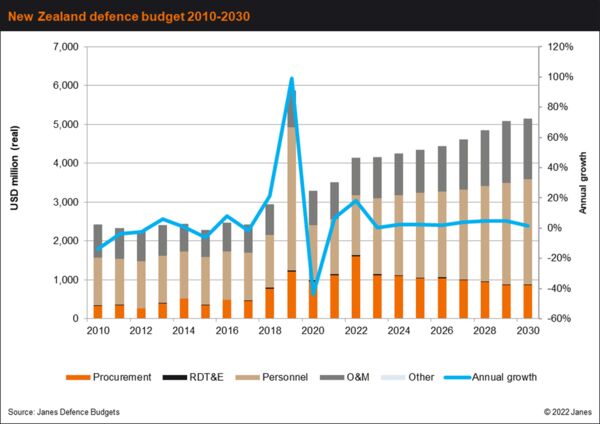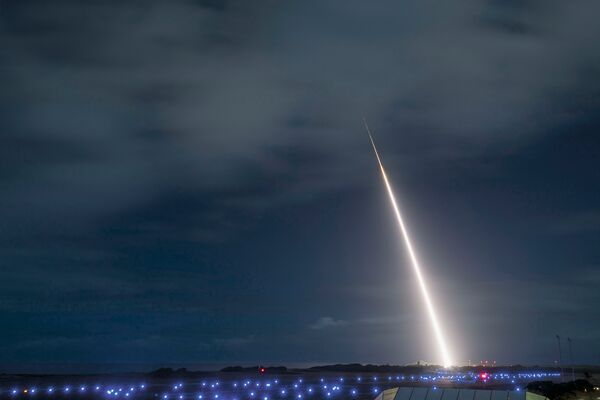- About
- Intara
- Capabilities
- Advisory
- Resources
- News
- Store
New Zealand increases defence budget by 6%
19 May 2023
by Jon Grevatt & Andrew MacDonald


New Zealand's total military expenditure is forecast by Janes Defence Budgets to reach the equivalent of about USD5 billion by the end of the decade. The spike in 2019 was caused by a one-off recognition of veterans' entitlements. (Janes Defence Budgets)
New Zealand announced on 18 May a 2023–24 defence budget of NZD6.52 billion (USD4.07 billion), a nominal 6% increase over the allocation of NZD6.15 billion in 2022–23.
In the new budget, the ‘Vote Defence Force' allocation receives NZD5.15 billion, while the Vote Defence appropriation receives NZD1.36 billion. Both represent year-on-year increases of about 6%.
Vote Defence Force covers salaries, training costs, capital expenditures, and military preparedness, while Vote Defence is allocated for managing procurement and sustainment activity and policy advice.
The capital expenditure for the New Zealand Defence Force (NZDF), which is sourced from Vote Defence Force, is NZD1.61 billion in 2023–24, an increase of 11% over the allocated NZD1.45 billion in 2022–23.
OCCAR and MBDA sign HYDIS² concept phase contract
17 May 2024
by Nicholas Fiorenza


OCCAR and MBDA have launched the HYDIS² concept phase. (MBDA)
The Organisation for Joint Armament Cooperation (OCCAR) and MBDA announced on 15 May that they signed a European Defence Fund (EDF) grant agreement and a linked procurement contract to launch the three-year HYpersonic Defence Interceptor Study (HYDIS²) concept phase on the same day. MBDA signed the agreements on behalf of the 19 industrial partners in HYDIS². In its press release, OCCAR valued the programme at EUR140 million (USD152 million), EUR80 million of which is co-funded by the EDF.
The concept phase aims to mature critical technologies focusing on the operational requirements of participating countries France, Germany, Italy, and the Netherlands, which will support the selection of a concept afterwards and will contribute to MBDA's Aquila counter-hypersonic interceptor concept. Another aim of the concept phase is to create an industrial network to develop future counter-hypersonic missile systems.
An MBDA spokesperson told Janes
Leonardo launches new C-UAS planning tool
16 May 2024
by Richard Scott


Leonardo's SkyTender C-UAS software aims to optimise the deployment of C-UAS. (Leonardo)
Leonardo Canada – Electronics has debuted a new counter-unmanned aircraft system (C-UAS) planning and assessment tool designed to enable rapid site evaluation and optimisation prior to equipment deployment.
Known as SkyTender, the software toolset has been evolved from the outputs of a Defence Research and Development Canada (DRDC) contract awarded to Leonardo in March 2022 under the Innovative Solutions Canada programme. The company has subsequently ‘productised' this functionality.
C-UASs using radio frequency (RF) sensors and effectors to defeat UAS threats are increasingly being deployed to protect both military installations and critical infrastructures such as airports, power stations, and ports. However, establishing the optimum positioning of system equipment has traditionally required expensive and time-consuming site surveys.
Hosted on a laptop, SkyTender is a planning application designed to support pre-mission planning and enable optimum placement of C-UAS equipment. The tool is able to evaluate spectral environments and topography and simulate threats, sensors, and platforms, thereby allowing operators to optimise the detect, track, and identify functions of their C-UAS solutions, and quantify the effectiveness of deployed C-UASs against defined threats.
Japan, US firm up co-operation to develop Glide Phase Interceptor
16 May 2024
by Kapil Kajal


The Standard Missile (SM)-3 Block IIA missile, pictured above launching from the Pacific Missile Range Facility in Hawaii, is jointly developed by the US and Japan. The MDA said the GPI joint development will be pursued in a construct similar to that used for the SM-3. (US MDA)
Japan and the US have firmed up their co-operation to jointly develop a Glide Phase Interceptor (GPI).
According to the Japan Ministry of Defense (MoD), the two countries signed a partnership agreement on 15 May to promote collaboration on research and development of the GPI.
The development of the GPI will be initiated in 2024 and it is scheduled to be completed in the 2030s, the MoD said. The GPI is envisaged to improve Japan's integrated air and missile defence (IAMD) capabilities, and deterrence and response capabilities of the Japan-US alliance, the MoD added.
The MoD said it will work “closely with the US Department of Defense to ensure the success of this joint development, and will strive to strengthen the alliance through joint development”.
New Zealand announced on 18 May a 2023–24 defence budget of NZD6.52 billion (USD4.07 billion), a nom...
Latest Podcasts
The value of OSINT for intelligence sharing
In this episode Harry Kemsley and Sean Corbett are joined by Phil Ritcheson Ph.D. to discuss why intelligence sharing is now more important than ever. They discuss the growing need for allied and partnership and how by using open sources facilit...
Listen nowJanes Case Studies
Using Janes Intara to build a common intelligence picture: Russian build up on the Ukrainian border
View Case StudyNews Categories
 Air Details
Air Details